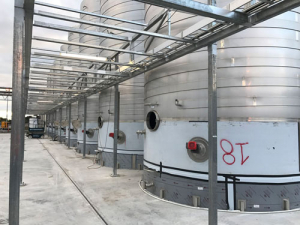With more than 60 million litres of tank space (20 percent of total capacity) either damaged or destroyed, how would Marlborough, the country’s largest wine region, cope with the upcoming vintage? Yet by the time the harvest really kicked off four months later, nearly all of that capacity had been replaced, either with temporary holding tanks, or new and repaired stainless steel tanks. It was a massive feat by steel manufacturers, who pulled out all stops to help the wine industry during a crisis.
One of those who played a major role in the rescue was Crown Sheet Metal. GM Andrew Horton says they employed dozens of extra staff to fulfill orders and within four months had replaced or repaired the equivalent of 41 million litres of wine tank capacity. Every company workshop, from Invercargill to Hamilton was involved in the job, with a number of outside companies helping out.
“In all fairness, we were lucky it happened when it did,” Horton says, “as the dairy industry was very quiet. Our workshops that are predominantly working for the dairy industry had the space to be able to take on capacity straight away.”
The call was made the day of the quake to offer only two sizes to those who needed new tanks, in an effort to streamline production.
“We came up with 140,000 litre tanks which were easy to manufacture and easy to transport. Making all the same size tank meant we could get uniformity and were able to put them through a lean manufacturing process very quickly. It was about getting as much volume as we possibly could. The other size was a smaller tank, 60,000 litres which was made in Invercargill.”
After going to the industry with prices, Horton says their books were filled with orders within 48 hours. In Blenheim itself, 80 extra staff were taken on to help with the work, with the other workshops able to contract dairy staff, who were not working on building or upgrades. “The logistics of that was pretty huge,” he admits.
While building new tanks per se wasn’t a difficult task, given they were crafted in the controlled environment of a workshop, the same cannot be said for the repair work.
“The biggest challenge was the retro fitting of the damaged tanks. Where the base had been damaged, we had to cut it off, leaving the whole top section. Then we had to have a whole new base come in and put that onto the tank, which was huge. In one winery, we had another workshop built over a week-long period and had huge cranes on site to lift those bigger tanks to the workshop, where we could then fit the bases.”
The task is not over, 12 months down the track either. Despite such a massive effort to get the region up and running for vintage 17, Horton says there is probably a few years of work still to be undertaken, albeit it won’t be the rush that occurred immediately after the quake.
“It depends on the individual winery and where they are with their insurance claims. It is also an opportunity for some wineries to look at re designing and maybe making a positive out of something negative. It is going to take another two to three years before every winery is back to where they want to be.”
The November 14 quake is not the first to impact the Marlborough wine industry. Back in 2013, a 6.6 quake struck the region in August. Horton says it was the lessons learned after that quake that allowed them to move so quickly last year. He describes their work in 2013 as a “practice run”.
“If we hadn’t had that practice run where we had to come up with new designs to strengthen the tanks, we wouldn’t have been able to do what we did. It took us a long time to redesign the tanks and come up with fixes back in 2013, but we had a lot more time before harvest. And luckily every design survived the November quake. We knew we could hit the ground running because we knew that everything we had done after 2013, had worked and survived. So we were able to go straight in and use those same designs.”
Horton admits he is proud of the team that worked around the clock to get the wine industry back up and running, but at the same time he says he is a little embarrassed that the tanks designed 20 years ago suffered so much damage.
“I look back at those designs and go, ‘oh we didn’t do well there’. But I am proud of where we were at after 2013 and very proud of the whole team. It was a huge effort.”












